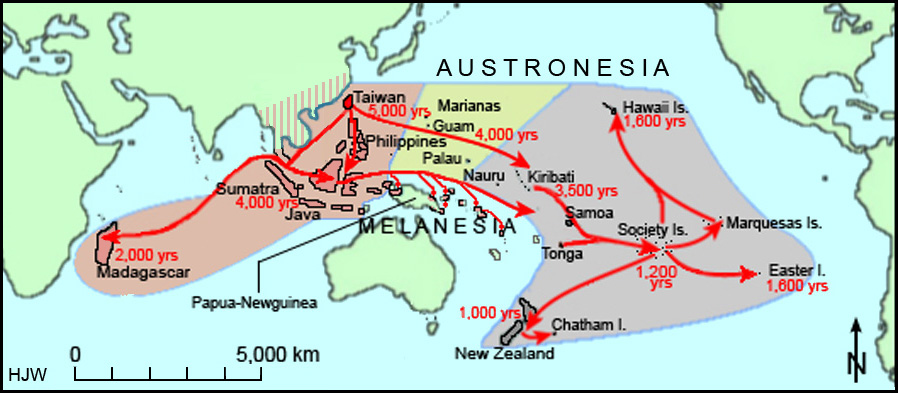The existing pattern of major language families records not only the migrations and conquests of our linguistic ancestors but also the continuing dynamic pattern of human movements, settlements and colonization’s of more recent centuries.
For example, the Indo-European languages have been dispersed far beyond their Eurasian homelands from the 16th century onward by Western European colonizers in America, Africa, Asia and Australia.
ADVERTISEMENTS:
In the process of linguistic imposition and adoption, innumerable indigenous languages and language groups in areas of colonization have been modified or totally lost.
For example, most of the estimated 1,000 to 2,000 Amerindian (Red Indian) dialects of Western Hemisphere disappeared in the face of European conquest and settlement.
The Slavic expansion eastward across Siberia, beginning in the 16th century, obliterated most of the Paleo-Asiatic languages there.
Similar loss occurred in Eskimo and Aleut language areas. In the northern reaches of both Asia and America, as shows are large linguistically distinct areas whose native populations are few in number and losing their own language as they adopt those of the majority culture which they have been forcibly made a part?
ADVERTISEMENTS:
In the Southern Hemisphere, the several hundred original Australian languages also loom large spatially on the map but have at most 50,000 speakers, exclusively Australian aborigines. Numerically and effectively, English dominates that continent.
There are numerous examples of linguistic conquest by non-Europeans. For example, in South-East Asia, there were extensive areas in which Austro-Asiatic language family was predominant.
But, the Austro-Asiatic language family has been reduced by Sino-Tibetan (Chinese, Thai, Myanmarian (Burmese), and Lao expansion. Similarly, Arabic—originally a minor Afro-Asiatic language of the Arabian Peninsula—was dispersed through much of North Africa and the South-Western Asia. At present, Arabic is the official language of twenty countries and spoken by over 2,000 million people.
The spread of language takes place with the migration of one linguistic group to another area. The colonization also leads to spread of language. For example, America, Africa and Australia were colonized by Europeans and the languages of the colonizers were adopted by the people of the new territories.
ADVERTISEMENTS:
Moreover, knowledge and use of a language of dominating culture may be seen as a necessity when that language is the medium of commerce, law, civilization and personal prestige.
It was on that basis, not through numerical superiority, that Indo-European languages were dispersed throughout Europe, India, Iran, Central Asia and Armenia.
Similarly, Arabic became widespread in Western Asia and North Africa through religious conversion and superiority of culture.
Emigration of population in new territories also helps in the spread of their language. Usually, those who are in or aspire for positions of importance are the first to adopt the new language of control and prestige. Subsequently, through schooling, daily contact, business and social interaction, other lower social strata of society may gradually adopt the language.
Such hierarchical diffusion of an official or prestigious language has occurred in many societies. For example, in India, during the 19th century, the English established an administrative and judicial system that put a very high premium on their language as the sole medium of education, administration, trade, and commerce.
Proficiency in English language was the hallmark of the cultured and educated persons (as knowledge of Sanskrit and Persian had been in ancient and medieval periods in India).
English, French, Dutch, Portuguese and other languages, introduced during the acquisition of empire, retain a position of prestige and even status as the official language in multilingual societies, even after independence has been achieved by the former colonial territories.
In Uganda and other former British colonies in Africa, a stranger may be addressed in English by one who wishes to display his or her educational and social status, though standard Swahili, a second language for many different culture groups, may be chosen if certainty of communication is more important than pride.
There are, however, many cultural barriers in the spread of language. Physical barriers restrict the spread of language.
Migrants and invaders generally follow paths of least topographic resistance and disperse most widely in areas of easy access (plains).
For example, on passing the barrier of the Pamirs and the Hindukush mountains, the Indo-European dialects and languages spread rapidly in the Indo-Gangetic plains. Similarly, the Pyrenees Mountains serve as a linguistic barrier separating France and Spain.
The Caucasus Mountains between the Black Sea and the Caspian Sea separate the Slavic speakers to the north and the areas of Ural-Altaic language to the south.
Migration, segregation, and isolation give rise to separate mutually unintelligible languages because the society speaking the parent protolanguage no longer remains unitary.
Comparable changes occur normally and naturally within a single language in word meaning, pronunciation, vocabulary, and syntax—the way the words are put together in phrases and sentences.
Changes may be gradual and cumulative, with each generation deviating in small degree from the speech patterns and vocabulary of its parents or it may be massive and abrupt. For example, English gained about 10,000 new words from Norman Conquerors of the 11th century-
In some seventy years (1558-1625) of literary and creativity during the reign of Elizabeth and James I, an estimated 12,000 words, based upon borrowing from Latin, Greek and other languages, were introduced. In Urdu language, thousands of words have been borrowed from Persian, Sanskrit, Arabic, Turkish and Hindi languages. The South Indian languages and Bengali language have borrowed a large number of words from Sanskrit language.

